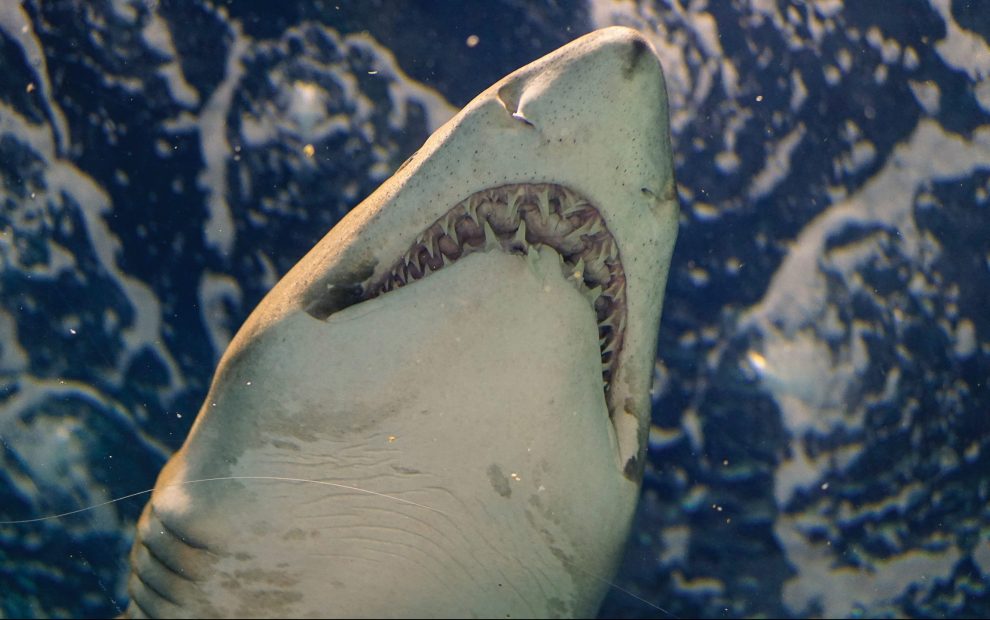Two new films, The Black Demon and Meg 2: The Trench, are the latest in a six-decade-long string of films about big, bad sharks noshing on people. Why does being eaten by an animal continue to engage us as entertainment?
Researchers suggest that the fondness some of us have for horror films is because the dismay over pretend monsters wanting to eat our legs as appetizers might help prepare us for coping with real-life scary things such as utility bills and the rising price of cheese.
Being frightened may also feel like entertainment to at least some of us, because it comes with an adrenaline rush, like riding a roller coaster or skydiving out of a plane. Scientists call this “recreational fear.”
Research on streaming programming during the pandemic argues from both ends of the spectrum—we watch more horror during horrible times to escape reality, and we watch less horror during horrible times because the scary stuff is right there on our doorstep.
We don’t definitively know why we seek out ways of frightening ourselves. Why we want to fear fish is perhaps even more puzzling, though being eaten is probably universally present on everyone’s “Ways I Don’t Want to Go” lists.
Do we fear animals devouring us because we eat them with impunity and figure payback’s inevitable? Possibly—yet there are exactly zero films about killer cows taking revenge (sure, there was Birds, but it wasn’t Chickens, now, was it?).
Perhaps being eaten scares us because, well, it has to hurt. I’ve got bald eagles living up in my trees, and let me tell you, watching them devour lunch is enough to give any carnivore pause.
Maybe we are vaguely aware of our arrogance at being near the top of the food chain and welcome the perverse shock that going into the savannah or the ocean brings to our imagined dominance.
Sharks do seem particularly designed to headline in scary movies. They are not at all cute. Those creepy blank eyes. That perennially frowning mouth. Lots of things not to like about a shark—the rows of sharp teeth, for 300 things. Baby sharks snack on one another in the womb, too. Not an attractive trait.
When Jaws launched the apex marine predator craze in the mid-1970s, it was dead serious. That bobbing swimmer, slowly nibbled like a worm on a hook. That snatched dog as an amuse-bouche. That soundtrack. We were terrified.
But in recent years, shark films have gotten as campy as those 1950s films about radioactive monsters. The Sharknado four-part franchise of sharks plucked out of the sea by windstorms and delivered to land, where they treat cities like salad bars; Hammerhead’s part-man, part-shark; 2-Headed Shark Attack and 6-Headed Shark Attack with self-explanatory ridiculousness.
In Black Demon and Meg 2, actual sharks aren’t menacing enough. The films reach back millions of years to resurrect a prehistoric species of gargantuan size: megalodons.
In Black Demon, the ancient shark is an avenging supernatural creature come to life because of global warming and corporations polluting the oceans. It takes out its crankiness on an oil rig and its workers, until hero Paul (Josh Lucas) admits his own culpability and explodes the structure—a plan that surely would have spilled even more oil, yes? That bit of illogic isn’t the only nonsense to try to ignore in this tired script. Worse, Demon breaks the first rule of horror films—it creates no suspense. The shark gets little screen time, so no sense of dread or threat is developed. Instead, the story focuses on a man making unethical career decisions to “protect his family” and then pouting because he’s misunderstood—a predictable and overworked narrative that is hardly tension-producing.
Sequel Meg 2 builds on the first Meg storyline of a living megalodon found in a long-hidden and unexplored deep-sea trench that shelters many species long-thought extinct. In Meg 2, scientific hubris leads to prehistoric giants escaping the trench and prowling around a vacation island. We are so surprised. Cliff Curtis reprises his role as monster hunter Jonas Taylor, and he’s engaging as a typically taciturn action hero. The characters are more fully drawn here than in Demon, the acting is better, and the script is snappier, with requisite one-liners and lots of high-tech and CGI coolness. Again, the shark is curiously missing for much of the first half of the film but finally appears to attack rafts, plow through docks, and threaten sweet young girls and small dogs.
Both films attempt to deliver the lessons we remember from Mary Shelley’s Frankenstein and midcentury sci-fi films: Humans mucking about in technology can destroy the order of the natural world. Compared to the human bad guys in these two films—who pillage and scar the land, seas, and skies for profit—the sharks don’t even seem that scary. They’re just excuses to make an action film, and most of the action is not about them.
Maybe that, in the end, is what really scares us about shark films and perhaps why we rather enjoy seeing sharks that are more silly fantasy than flesh. We begin to suspect that the most frightening monsters are not up there on the screen but down here in the mirror.
This article also appears in the March 2024 issue of U.S. Catholic (Vol. 89, No. 3, pages 36-37). Click here to subscribe to the magazine.
Image: Unsplash/Karen Zhang













Add comment